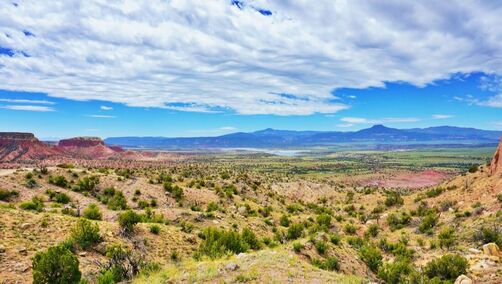|
By Anya Shukla Full disclosure… I understand maybe 50% of what happened in “House Made of Dawn.” Actually, more like 40%. The book consists of so many layers. It’s one of those novels with in-depth metaphors that can only be unraveled when you read two sentences in just the right way. A brain-teaser of a book that—although small—could kill someone with its sheer intellectual power. The novel is confusing, but in the way that good literature is confusing: you have a certainty that everything will figure itself out, that there will be no loose ends, that you can unlock all the similes and allegories after days of close reading. Did I desperately want to SparkNotes everything? Yes. Did I? Well… Review: N. Scott Momaday’s “House Made of Dawn” revolves around Abel, an Indigenous man who returns to his grandfather’s home in New Mexico after fighting in World War Two. Over the next seven years, a series of events force him to move away from the reservation and back... and determine how much of his culture he wants to retain. Momaday sections the book into four parts, intermixing Abel’s narration with stories, flashbacks, and other characters’ memories. Throughout the book, he explores the dichotomy between nature and city, Indigenous knowledge and the “white” way of living. Momaday's language is compact, almost abrupt, but if one reads between the lines, they might start to re-examine the value of culture, tradition, and history. What I Loved: The descriptions of nature. Momaday speaks about the natural world with such reverence and beauty: “It was dawn. The first light had been deep and vague in the mist, and then the sun flashed and a great yellow glare fell under the cloud. The road verged upon clusters of juniper and mesquite, and he could see the black angles and twists of wood beneath the hard white crust; there was a shine and glitter on the ice” (pg. 25). Momaday paints in every last detail of his landscapes, allowing me to easily picture the Southwest’s multicolored plains and rolling hills. His words are almost holy: I read them and feel a cathedral-hush around me. Momaday also illuminates the struggle between the traditional and new ways of life. Abel’s friend notes that, when an Indigenous person moves from the reservation to a predominantly-white city, they have to adapt: “That’s the only way you can live in a place like this. You have to forget about the way it was, how you grew up and all” (pg. 238). Abel, however, “didn’t want to change, or I guess he didn’t know how” (pg. 238). Momaday chronicles Abel’s attempts to live in an unfamiliar world, compounded by his PTSD from World War Two and time away from his reservation, and provides insight into the issues faced by Indigenous people in the mid-20th century. What I Didn’t Love: For someone who (like me), relies on action to keep them engaged in a novel, the first 50 pages of “House Made of Dawn” feel a little like plodding through mud; the excess of descriptions/scene-setting make the opening chapters hard to get through. But once the affairs (romantic and otherwise) come out of the woodworks, it’s smooth sailing through to the end. Additionally, most Pulitzer-winning-novels I’ve read tend towards economical text, creating a barrier between a reader and the novel’s characters through the scarcity of words. This book is no exception: I feel so removed from Abel and his struggles. I know that distance was a choice, bolstered by the novel’s various third-person narration styles, but I don’t have to enjoy it. When Momaday does wring beauty from his terse sentences, he describes the landscape, not the protagonists. It’s almost as if nature is the main character, and the people the afterthoughts. Which is, once again, a choice… BIPOC Book Connections: Momaday explores the importance of oral tradition, just like Nalo Hopkinson in "Midnight Robber." During the second part of "House Made of Dawn," an Indigenous pastor, Reverend Tosamah, speaks about the Book of Genesis. He believes that John attempts to inflate the “Truth” in the Book’s opening lines by mentioning God and other religious figures: “He imposed his idea of God upon the everlasting Truth. ‘In the beginning was the Word…’ And that is all there was, and it was enough” (pg. 157). Tosumah feels that words, the centerpiece of oral storytelling, are holier than all else. He notes that the white community has lost its appreciation for words as an “instrument of creation” (pg. 160), while reminding his audience of oral tradition’s importance in Indigenous culture. Indigenous communities have passed down fables, advice, and information—“always but one generation from extinction” (pg. 161)—over centuries. Momaday argues that this knowledge's precarious nature makes it sacred, not less than. Perhaps this is why he starts and ends his book with “dypaloh” and “qtsedaba,” words which, according to PBS, demarcate oral stories in the Jemez tribal tradition. He reclaims and reimagines the oral tradition in a physical form. A Quote I Would Like On Goodreads: “Of all the places that he knew, this valley alone could reflect the great spatial majesty of the sky. It was scooped out of the dark peaks like the well of a great, gathering storm, deep umber and blue and smoke-colored… It was almost too great for the eye to hold, strangely beautiful and full of distance. Such vastness makes for illusion, a kind of illusion comprehends reality, and where it exists there is always wonder and exhilaration” (pg. 46). Up next: “The Book of Unknown Americans” by Christina Henriquez.
0 Comments
Your comment will be posted after it is approved.
Leave a Reply. |
Archives
February 2023
Categories
All
|

 RSS Feed
RSS Feed